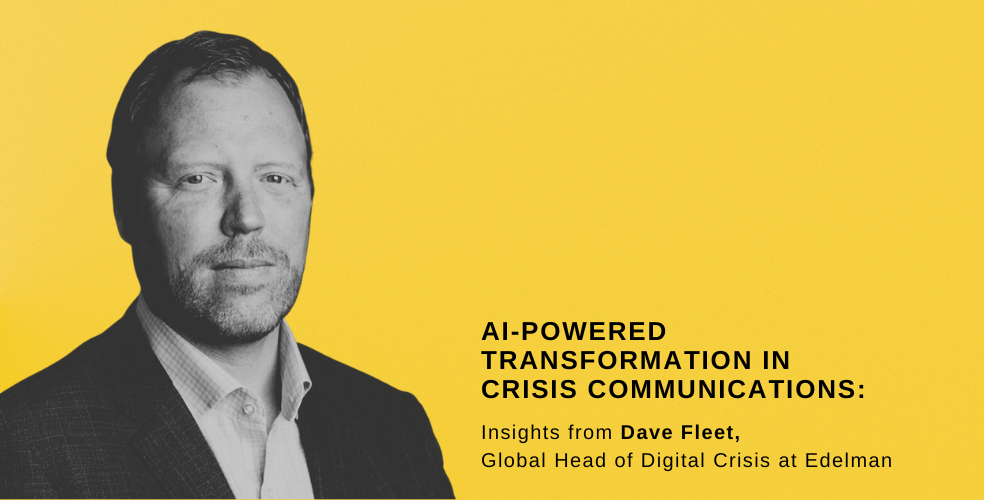 August 14, 2023
August 14, 2023

AI-Powered Transformation in Crisis Communications: Insights from Dave Fleet, Global Head of Digital Crisis at Edelman
August 21, 2023
With nearly two decades of experience advising senior clients on reputation management and digital communications, Dave Fleet has been at the forefront of navigating the intersection of technology and crisis communications. As the Head of Global Digital Crisis at Edelman, he is responsible for integrating digital, data, and intelligence into Edelman's global crisis offerings.
Dave's insights and expertise in the realm of crisis communications are highly anticipated at the upcoming "Virtual AI in PR Summit", scheduled for October 12th. In this interview, Dave shares his perspective on the transformative role of AI in crisis communication strategies. From AI's impact on crisis management to its ethical considerations and the dynamic balance between automation and human touch, Dave provides invaluable insights into the evolving landscape of crisis communications in the age of AI.
AI is transforming various industries, including crisis communications. From your viewpoint, how has AI impacted the field of crisis communications, and what are its most promising applications?
Let's be clear: AI has already impacted crisis communications in innumerable ways – it was just different until the last year, and more behind-the-scenes. The interest we're seeing in this space now is thanks to the breakthrough in awareness and usage of generative AI over the last nine months or so, which brought more creative applications to the forefront and made AI more visible to the end user.
To understand the impact of generative AI on crisis communications, we need to look at it both as users and as potential targets. From a user perspective, we're going to see a lot of companies increasingly using these tools to streamline certain activities - content creation, for example, or scenario development for tabletop exercises, or summarizing data. As these tools evolve, I expect we’re going to see them increasingly tackle these kinds of activities with the level of sophistication we need. On the other hand, we're going to see new and evolved threats against organizations in the months and years ahead, and a growth in the frequency of certain types of issues.
We can't assess these platforms in a static way - they're evolving incredibly quickly. Just as those who wrote off social media in 2007 because they didn't care what you ate for your lunch were making a mistake, those who write the potential of AI off now are going to be left standing as these tools continue to evolve. That applies to its applications and its threats.
Crisis events often require rapid responses. How can AI technologies aid PR professionals in monitoring and analyzing real-time data during a crisis?
If we're focusing on the time pressure of rapid responses in particular, there are two paths to lessening that pressure.
Firstly, the success or failure of a rapid response often comes down to friction. Everything that acts to unnecessarily slow down decision making or execution hurts your response. I think we're going to see these tools work to reduce friction in crisis responses - automating or streamlining activities that bottlenecked the process – things like quickly creating draft content, streamlining data analysis analyzing data, and so on.
Secondly, the best way to respond to a situation is often to get ahead of it. We're seeing more and more tools building in predictive capabilities that let us know when stories are likely to spike. Tools like NewsWhip and TalkWalker are staples in the modern crisis toolkit, but we're also looking at other platforms that give us a broader risk-sensing lens. I think we’re going to see more tools like this becoming widely available and adopted.
AI-powered sentiment analysis plays a crucial role in understanding public perception during crises. Can you share examples of how sentiment analysis has influenced crisis communication strategies?
Sentiment analysis is an important signal at all stages of a crisis. It can be difficult through automated tools and analysis to get a fully accurate view on sentiment – some emotions, even AI has difficulty gauging. However, direction of change in sentiment is crucial to monitor in the lead up to, throughout and following a crisis. For example, when we're looking at anticipated issues and crises, it lets us examine how an organization is perceived, and where potential vulnerabilities are. When we're in the midst of a response, it lets us get a real-time pulse on issues and to fine-tune responses, which is especially important in two-way channels such as community management.
With that said, it's important to remember that as valuable as sentiment analysis is, it's just one signal - and is not always representative of the broader situation, especially when you consider the polarization that we’re seeing online and the challenges of monitoring some of the key channels nowadays. You may have a customer backlash with minimal social chatter; you may also have negative conversations online with minimal customer impact.
The volume of digital content generated during a crisis can be overwhelming. How do you see AI assisting communication teams in efficiently managing and filtering information during high-pressure situations?
AI can be a very powerful tool in helping sift through a high volume of digital content and allowing us to, in a matter of seconds, identify the content that matters the most. Timing is important in crisis management, and AI immediately helps us identify the key areas to focus our attention on: the lines of commentary that are driving the most conversation, emerging themes or questions, accounts and types of accounts that drive the highest shareability, etc. This allows communications teams to monitor and respond to these evolving reactions effectively.
As AI becomes more prominent in crisis communications, what ethical considerations do PR professionals need to be mindful of to ensure responsible and transparent communication?
A few of the major considerations on this front include copyright issues and ownership of AI-generated content; considerations around disclosure of AI use; avoiding inaccuracy, bias or defamatory information in content; and protecting the information confidentiality when using these tools.
AI can augment crisis response, but the human touch remains essential. How do you recommend striking the right balance between AI-powered automation and human decision-making in crisis communications?
I think we’re going to see AI continue to do what it has done in other areas in recent years – commoditize the work that is low in the value chain, and streamline other work. But a key concept for people to remember right now is that of “human in the loop” – as things stand, we need to make sure that real people have oversight of the inputs and outputs of these tools. There are too many issues of hallucination and too much risk around inaccuracy, bias and the potential for offensive content to get around that. It’s also critical for all of the reasons we’ve already covered here as well as the reality that effective communication is all about empathy and for one important addition: while these tools can do a great job of replicating emotion, they don’t actually feel it. When you’re in a high-stakes crisis, you can’t overlook the importance of this.
In your experience, what challenges have you encountered in incorporating AI into crisis communication strategies, and how have you addressed or overcome them?
This space is still nascent, and things are changing daily. Right now the biggest challenge is the pace of evolution paired with the lack of broad understanding of these technologies within companies, particularly at a senior level. For example, we’ve already encountered companies looking to use these tools in ways that could be problematic, or who misunderstand what they reflect. Many of the challenges we’re seeing are just emerging now, and are likely to be exacerbated as adoption of these tools becomes more widespread and as these tools keep advancing.
The other challenge we’re considering is that of confidentiality in the use of these tools. Crisis situations are typically highly sensitive, so there’s risk inherent in the potential for employees to mistakenly input confidential information into these tools, which could then be ingested into the training data for those tools. This should be mitigated as we see more enterprise-ready tools come to market, with safeguards and security policies built in.
As AI technologies continue to evolve, what trends do you foresee shaping the future of crisis communications?
Crisis communications is more complicated than ever and I don’t see that changing. We’re living in a world of crisis where frequently occurring issues are increasingly the norm. This is the latest in a long line of disruptions and I think its impact is going to continue to ripple through this field.
From an AI perspective, it’s evolving and a lot of what we’re thinking about is still hypothetical. We’re going to see AI begin to permeate the creative aspects of crisis communications, just as the broader communications field will. I do think we’re going to see increasing challenges around misinformation and disinformation, impersonation, and information security – all of which are going to become more challenging to manage. We’re going to see legal precedents set around copyright and ownership of content. We’re also quite likely to see new types of issues emerge that we can’t yet predict as we start to see new tools emerge and applications interacting in ways we can’t anticipate.
The biggest macro risk here that of these trends intersecting and working together to take us towards a zero-trust landscape where people no longer trust anything we read, see or hear. For now there’s no need to be hysterical about these risks, but we’re watching trends around them all closely. In some cases, I expect we’ll see AI solutions emerge to help solve for these issues too.
As we conclude this illuminating conversation with Dave Fleet, it's evident that the fusion of AI and crisis communications is a dynamic space brimming with possibilities and challenges. Dave's expertise provides a crucial roadmap for navigating this transformative journey.
For those seeking a deeper dive into the world of AI in crisis communications, mark your calendars for the "Virtual AI in PR Summit" on October 12th. Dave Fleet will be a featured speaker, sharing further insights and strategies to leverage AI effectively in the realm of public relations. Don't miss the chance to learn from one of the industry's foremost experts. Register now and secure your spot to join the conversation at the forefront of AI-driven crisis communication strategies.